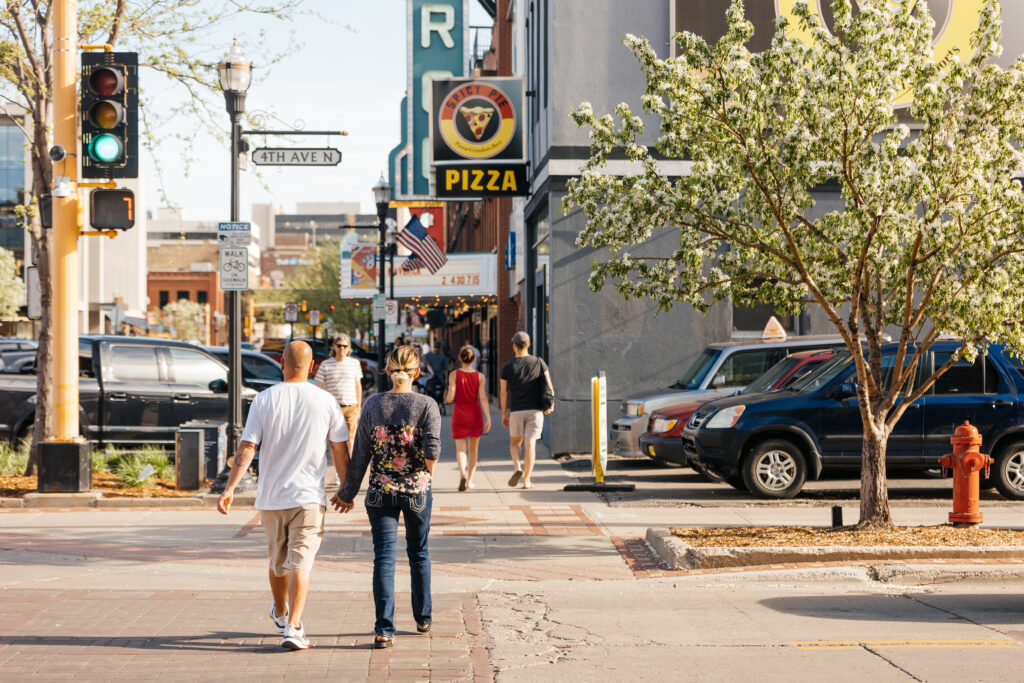
| By Helmut Schmidt |
This article originally appeared on InForum. The featured image is by M.Schleif Photography.
Renaissance Zones are an economic winner for North Dakota’s cities and they are about to get a boost from state lawmakers with changes to make the program even more attractive to developers, businesses and homeowners.
You don’t have to go far to see how well the program works.
Downtown Fargo could be the program’s poster child.
Property values in Fargo’s old urban core have leaped since the city established its Renaissance Zone after the program became state law in 1999.
Downtown Fargo properties had a net taxable value of about $210 million in 2003. That number is now about $737 million, city records show.
If the value of non-taxed properties is included, downtown property values jumped from about $200 million in 1999 to $900 million now, Jim Gilmour, Fargo’s director of strategic planning and research said Tuesday, April 4.
“A rising tide lifts all property values,” Gilmour said.
The Kilbourne Group is one of the most active developers in Fargo’s downtown, rehabilitating or constructing about 15 buildings in the last two-plus decades.
“Renaissance means rebirth. And I think we’ve absolutely seen a rebirth of downtown Fargo in my lifetime,” Kilbourne Group spokeswoman Adrienne Olson said.
The difference in Fargo’s downtown Renaissance Zone from the early 2020s to today “is palpable,” Olson says.
“In my opinion, downtown development wasn’t possible without the Renaissance Zone. … It made it possible for private investment to come into downtown, with the possibility of a return” on investment, Olson said. “It really all comes down to economics. The projects simply weren’t feasible before.”
Legislation expanding Renaissance Zone offerings has broad support and is steadily working towards final legislative approval, said the bill’s primary author, state Sen. Jonathan Sickler, R-Grand Forks.
Senate Bill 2391, revised by the House and sent back to the Senate, has been recommended for passage by the Senate’s Finance and Taxation committee, Sickler said.
However, on Wednesday, April 5, the Senate narrowly failed to concur with the House amendments. The bill now goes to a House-Senate conference committee to work out a compromise, Sickler said.
Gov. Doug Burgum had earlier called on the Legislature to make improvements to the program.
Changes proposed to the Renaissance Zone program, which is overseen by the state Department of Commerce, include:
Renaissance Zone tax credits are used to encourage developers, businesses and homeowners to construct new buildings or renovate older structures in blighted or underused areas. The tax breaks currently run for up to five years, during which time the property owners continue to pay property taxes on the value of the land.
Since the program began, 62 cities have taken part, but only 53 of those zones are active, a spokeswoman for the Department of Commerce said Wednesday. To date, about 1,550 projects have gotten a final approval for the tax credits.
Any city that applies for the program can designate 34 blocks as a Renaissance Zone, though cities with populations of more than 5,000 can add a block for every 5,000 people above that base. The maximum number of blocks in a Renaissance Zone is 49, which is what Fargo has.
A Renaissance Zone has to have a continuous boundary and the blocks have to be contiguous, though the current law allows a grouping of up to three blocks not connected to the rest. For Fargo, that cluster is in the Oak Grove neighborhood just northeast of downtown. Renaissance Zone tax credits available there have helped spur apartment and condominium construction.
Chad Peterson, chairman of the Cass County Commission, believes being able to use Renaissance Zone tax credits to incentivize development in other parts of Fargo would be a good move.
“Isn’t it time to maybe start focusing somewhere else?” Peterson said. “Downtown has been an absolute victory.”
Peterson said the planned BLOC building on the 1600 block of South University Drive, with its mix of apartments and commercial space, will be good for that part of town in the long run. He says further development along the South University Drive corridor should be encouraged.
“That whole corridor, if I’m Fargo, that’s my next core development,” Peterson said. “I guess I contend that we’ve done a great job downtown, let’s move somewhere else and do a great job there.”
Jim Gilmour, Fargo’s director of strategic planning and research, said Fargo’s downtown still needs incentives such as the Renaissance Zone as well as the city’s tax increment financing or payment in lieu of taxes programs. All incentives help developers deal with high interest rates and construction costs and continue construction momentum.
But he agrees with Peterson that “some of the old commercial corridors are ripe” for incentives. In addition to parts of South Univesity Drive, Gilmour said sections of Main Avenue could also be good candidates for renewal.
“Those are two corridors we should look at for one of those satellite districts,” Gilmour said.
Kilbourne Group’s Olson said being able to apply the Renaissance Zone designation to blocks in other parts of Fargo should work as well for the city as it has for downtown.
“We’re in favor of it because we’ve seen the impact that the Renaissance Zone has in the neighborhood that we do work in,” Olson said.
The program over time “is a good investment for taxpayers” because it helps grow the city’s tax base, she said.
“The bottom line is that these infill incentive programs bring private investment to places where public infrastructure already exists. It’s a payoff for taxpayers.”